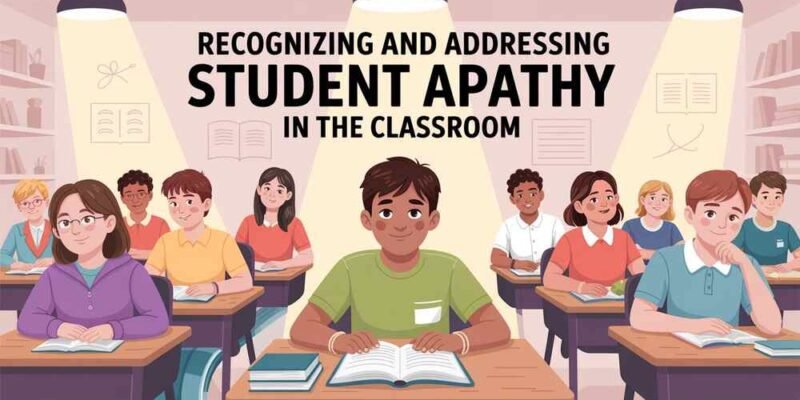Student apathy—a lack of interest, motivation, or engagement in learning—is an increasingly common challenge educators face in classrooms worldwide. When students appear indifferent, disengaged, or unmotivated, it affects their academic performance and disrupts the overall learning environment. Left unaddressed, apathy can lead to long-term academic struggles, low self-esteem, and a diminished love for learning. Understanding the root causes of student apathy and implementing effective strategies to counter it is essential for every teacher aiming to foster a dynamic, inclusive, and productive classroom.
Educators must recognize signs like disengagement and low participation to effectively identify and combat student apathy. Key strategies include building strong relationships, offering relevant content, and fostering a supportive classroom environment. Addressing underlying issues early can reignite motivation and promote a more active, inspired learning experience for every student.
What Is Student Apathy?
Student apathy goes beyond the occasional lack of enthusiasm. It’s a pattern of disinterest where students consistently exhibit low effort, show little curiosity, avoid participation, and demonstrate a lack of concern for their academic outcomes. Apathy can manifest in various ways:
- Frequent absenteeism or tardiness
- Incomplete or missing assignments
- Lack of participation in class discussions or activities
- Passive behavior and minimal eye contact
- Disengagement from peers and teachers
- Verbal expressions of boredom or indifference
Recognizing these signs early is key to intervening before apathy becomes deeply entrenched.
Causes of Student Apathy
To effectively address student apathy, educators must first explore the underlying causes. Often, apathy is a symptom of deeper issues, both personal and systemic:
Lack of Relevance
Students are more likely to disengage when they feel the material doesn’t apply to their lives. Motivation naturally decreases if they can’t connect lessons to real-world situations or personal goals.
Low Self-Efficacy
Students who believe they are incapable of succeeding may stop trying altogether. Past failures, learning difficulties, or a lack of encouragement can lead to a defeatist mindset.
Mental Health Challenges
Depression, anxiety, trauma, and stress can all contribute to emotional withdrawal and reduced motivation. These issues are often invisible but have a profound impact on engagement.
Overload and Burnout
Students can feel overwhelmed by academic pressures, extracurricular commitments, and social stressors. This often results in apathy as a coping mechanism to deal with stress.
Classroom Environment
A rigid, test-driven, or overly competitive classroom can stifle curiosity. A lack of positive student-teacher relationships and limited opportunities for student voice can also lead to disengagement.
Strategies to Address Student Apathy
Combating apathy requires more than increased discipline or stricter rules. It calls for empathetic, creative, and responsive teaching strategies that focus on connection, relevance, and empowerment.
Build Strong Relationships
Apathy often diminishes when students feel seen, heard, and valued. Take time to learn students’ names, interests, and backgrounds. A simple “How are you?” can open the door to deeper trust.
- Offer personalized feedback.
- Celebrate small successes.
- Show genuine interest in students’ lives outside the classroom.
A caring teacher can be the catalyst for renewed motivation.
Connect Learning to Real Life
Demonstrating the real-world value of academic content helps students see purpose in their work.
- Use examples from current events, popular culture, or community issues.
- Let students choose project topics that interest them.
- Integrate hands-on, experiential learning opportunities.
When students understand how their learning applies to their goals and interests, they become more invested.
Differentiate Instruction
Students disengage when lessons don’t match their learning style or pace. Differentiation helps meet students where they are.
- Offer varied assignments (videos, art, writing, presentations).
- Provide choices in how students demonstrate their understanding.
- Use flexible grouping and pacing.
Tailoring instruction to student needs fosters confidence and a sense of ownership over learning.
Promote Student Voice and Agency
Empower students by giving them a say in their learning environment.
- Invite feedback on classroom rules or assignments.
- Encourage student-led discussions or peer teaching.
- Allow choice in reading materials or project formats.
When students feel their voices matter, they are more likely to engage meaningfully.
Create a Positive and Safe Classroom Climate
Apathy can thrive in environments where students fear judgment or failure.
- Emphasize growth over grades.
- Encourage collaboration over competition.
- Establish routines and expectations that promote respect and inclusion.
A supportive atmosphere enables students to take risks and re-engage with learning.
Use Technology Thoughtfully
Interactive tools and digital platforms can reignite interest, especially among tech-savvy students.
- Use gamification elements like badges or leaderboards.
- Incorporate multimedia presentations or interactive simulations.
- Allow students to create digital projects or blogs.
Technology should enhance—not replace—meaningful instruction and connection.
Address Underlying Mental Health Needs
Apathy may be a symptom of more profound emotional or psychological challenges.
- Pay attention to changes in mood or behavior.
- Work with school counselors and parents to support struggling students.
- Create a stigma-free environment where seeking help is encouraged.
Sometimes, addressing mental health is the most crucial academic intervention.
The Role of Teachers and Schools
While individual teachers can do much to combat apathy, systemic support is crucial. Schools should:
- Provide professional development focused on student engagement and mental health.
- Support teacher collaboration to share strategies and resources.
- Foster inclusive policies that prioritize student well-being alongside academic performance.
Teachers also need time, flexibility, and administrative support to create engaging lessons and build strong student relationships.
Conclusion
Student apathy is not a sign of laziness or defiance—it’s a message. It signals disconnection, overwhelm, or a loss of purpose. Empathy and intentional strategies are the keys to helping students re-engage.
Educators can transform apathy into curiosity and indifference into inspiration by creating a classroom that values relationships, relevance, and respect. The journey to rekindle a student’s motivation may be challenging, but it is always worthwhile. After all, every student deserves to feel excited about learning again.
Do Read: Expert Assignment Help Services for Academic Success













